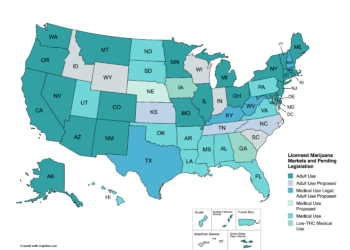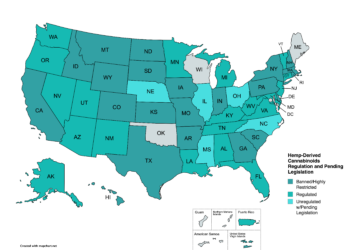Whether it’s called a turf war or not, the conflicts between the licensed cannabis market and the less-regulated hemp market are heating up as state leaders try to curb hemp-derived cannabinoids (HDCs) in the name of public safety.
California is the latest state to try to ban HDC consumable products via emergency order after legislation to bring HDC products into the regulated cannabis market didn’t advance. And recent emergency orders in Missouri and Tennessee are being challenged in court.
But at least 15 other states have incorporated hemp products into their legal cannabis programs, with New Jersey Gov. Philip Murphy signing SB 3235 on Sept. 12. As more regulated cannabis companies get into hemp production and manufacturing, some people in the hemp and cannabis industries seek compromise rather than competition.
One of the challenges cannabis regulators face is preventing hemp-derived THC imported from other states from entering the legal cannabis markets.
Hemp cultivators and producers in most states are not regulated as heavily as licensed cannabis farmers and manufacturers. In addition to public safety concerns, particularly around pesticides, less regulation means the product can be obtained at a lower price, undercutting the regulated market.
It was something that the California Assembly Committee on Health called out in its report on AB 2223.
“The bill’s author may wish to consider more clearly limiting the ability of manufacturers to use industrial hemp to extract THC and comparable cannabinoids, even when integrated into the DCC-regulated marketplace,” the report said.
In 2023, the California DCC published “The Hemp Report,” which detailed many of the challenges of bringing hemp products into the regulated supply chain. For example, the state’s track and trace program would need to be reconfigured. And hemp cultivators would have more requirements.
They also raised enforcement concerns. “The introduction of hemp plant matter in the commercial cannabis supply chain may increase the opportunity for inversion and diversion of illegal cannabis and may create enforcement challenges as there are no visual physical indications delineating hemp and cannabis plant material, or cannabinoids derived from hemp as opposed to cannabinoids derived from cannabis,” the report said.
It also discussed market impacts. Demand for cannabis may drop, which would decrease wholesale prices and hurt cannabis cultivators. But that may lead to lower prices for consumers, while retailers could increase their customer base.
The Health Committee passed AB 2223, noting California Gov. Gavin Newsom had introduced amendments that would ban any intoxicating THC in consumable products outside the licensed market. The Senate Committee on Appropriations placed the bill in the suspense file, and it was not voted upon before a legislative deadline.
Governors try to ban through emergency procedures
Weeks later, Newsom announced a sweeping ban of all consumable HDC products containing a detectable amount of total THC during a Sept. 6 news conference. As of Sept. 12, his office had not yet filed the proposed emergency regulation with the state Office of Administrative Law (OAL).
“We’re wondering why it’s taking so long,” Jonathan Miller, general counsel of the U.S. Hemp Roundtable, told CRB Monitor News. He said it’s likely because the governor is learning the move is “completely illegal” and needs to go through the regular 45-day rulemaking process.
“The law is crystal clear. You can’t go through emergency procedures for regulations like this.”
Once the proposed rules are filed, the OAL would have 10 calendar days to approve or disapprove them under the emergency procedure. The public comment period would be only five days.
Newsom and California Department of Public Health Director Tomás Aragón said in a statement that emergency rules are necessary because of “increasing health incidents related to intoxicating hemp products,” especially among children.
The OAL’s website explains that pursuant to government code, unless the emergency is spelled out in statute, the agency must present findings “describing specific facts supported by substantial evidence” to demonstrate an emergency.
“In addition, if the emergency existed and was known by the agency in sufficient time to have been addressed through nonemergency regulations, the finding of emergency shall include facts explaining the failure to address the situation through nonemergency regulations,” the website says. “A finding of emergency based only upon expediency, convenience, best interest, general public need, or speculation, is not adequate to demonstrate the existence of an emergency.”
Missouri Gov. Michael Parson has received headwind from the state’s Secretary of State Jay Ashcroft in his attempt to enact a ban on intoxicating HDCs through emergency rulemaking. While Ashcroft halted emergency rulemaking for the Division of Alcohol and Tobacco Control (ATC) to prohibit psychoactive cannabis products from being sold in licensed liquor stores, the Department of Health and Human Services began enforcing the ban Sept. 1.
The governor also created a task force between the Attorney General’s Office and the ATC to combat unregulated HDC products.
“While there are some out there who want Missourians to believe the proliferation of these harmful products is not an emergency or threat to the well-being of Missouri children, I, along with the Attorney General, DPS, DHSS, and other health experts, strongly disagree,” Parson said in a Sept. 10 statement. “Together, with the help of the Attorney General and his team, we will root out these cannabis products being deceptively marketed to our children until such time the General Assembly provides the statutory framework for commonsense regulations.”
A lawsuit has reportedly been filed to fight the Missouri ban, and Miller said one in California will happen if the Newsom follows through with his order.
“If you ultimately choose to formally issue these regulations on an emergency basis, we will challenge their legality, and we will win. Please don’t waste scarce taxpayer resources fighting a battle that is unwinnable,” Miller said in a Sept. 12 open letter to the governor asking for more cooperation with the hemp industry. “We’d much rather work with you rather than pursue you in court.”
The Ninth Circuit Court of Appeals, in a trademark infringement case in California, already ruled that delta-8 THC is legal under the federal 2018 Farm Act. The Fourth Circuit Court of Appeals also came to the same conclusion this month regarding hemp-derived THC-O in an employee termination case.
However, the question as to whether states have the right to ban HDCs is still pending in the Fourth, Eighth and 10th circuit appellate courts.
Other states control HDCs within licensed programs
In the meantime, at least 15 states have incorporated hemp into their regulated cannabis programs in some fashion: Alaska, Colorado, Connecticut, Maryland, Massachusetts, Michigan, Minnesota, Montana, Nevada, New Jersey, New York, Oregon, Rhode Island, Vermont and Washington.
Many of those states require hemp businesses to be registered or licensed by the cannabis regulator.
Lawsuits are pending in Alaska and Maryland. A state judge granted a temporary injunction preventing the hemp rules from going into effect in Maryland, but a TRO was denied in Alaska.
Michigan has been regulating hemp processing within its Marijuana Regulatory Agency since 2021. Growers and processors must be licensed. Recently, the state has ramped up enforcement efforts. It recently filed complaints against two licensed manufacturers accused of not properly tracking imported THCA from unlicensed growers to use as ingredients in products.
In Oregon, hemp cultivators already licensed by the state Department of Agriculture (ODA) can obtain certificates from the Oregon Liquor & Cannabis Commission (OLCC) to conduct business with licensed cannabis companies. The cost of a hemp certificate is $1,200 annually.
There are currently 28 active OLCC hemp handler certificates and one active hemp grower certificate, according to the OLCC. In comparison, the agriculture department has 179 actively licensed growers and 211 licensed hemp handlers. There are also 194 ODA hemp vendor licenses.
Hemp products undergo compliance testing after being entered into Metrc and before being transferred to any cannabis licensee.
An unidentified OLCC program expert said in an email, provided by department spokesman Matthew Van Sickle, that the program “seems to be working very well. It goes a long way toward making sure that hemp ingredients are largely following the same kinds of testing and recordkeeping requirements that apply to marijuana ingredients.”
They said the biggest challenge is educating the industry on how the process works and labeling requirements.
“Some businesses have explored the possibility of sending the hemp biomass directly to OLCC-licensed processors for extraction. But the regulations require potency testing on all incoming hemp commodities and products to mitigate potential issues of inversion (e.g. ‘THCA hemp’),” the expert said. “The practical effect of this is that every 50 lbs batch of biomass would have to be tested prior to transfer to an OLCC processor. This is especially difficult for fresh frozen material, where the weight is significantly higher because it has not been dried.”
The low participation of growers in the hemp certificate program reflects the fact that grower certificates can currently only transfer biomass, but not usable hemp flower or any other processed material. And growers that do not have an OLD handler license have the challenge of potency testing on biomass, the expert said.
When it comes to retail sales in Oregon, Hemp Roundtable’s Miller told CRB Monitor News, “We think the milligram limits are quite low and don’t allow for a whole panoply of hemp products to be sold at retail.” But the hemp program otherwise “in general works well.”
He said that while the Hemp Roundtable demands robust regulations of HDC products in terms of public safety and age limits, “Our preference is that hemp is not limited to dispensary programs.”
The OLCC on Aug. 28 introduced new draft rules to implement HB 4121 regarding artificially derived hemp cannabinoids. The public comment period ends Sept. 27.
Not a war?
Hemp advocates insisted during a U.S. Hemp Roundtable webinar on Sept. 4 that there’s no war between the cannabis and hemp industries, especially as major multi-state operators enter the hemp space.
“We’re not in war with ourselves. This being painted as a war is ludicrous to us,” said Cheech and Chong Global Holdings Co. CEO Jonathan Black as a speaker on webinar. Cheech and Chong sells low-THC beverages in stores licensed by the California Alcohol and Beverage Control and a 50 mg drink at licensed cannabis retailers. It also sells other HDC and cannabis products.
Black said they were hoping to amend California’s AB 2223 in the Appropriations Committee to add a 5% tax that would have brought in approximately $250 million in revenue. But the bill was “doomed to fail,” he said, because “it would have cost the state million and millions of dollars they didn’t have.”
Following Newsom’s order, Black said in an email to CRB Monitor News, “This proposed ban not only impacts our operations, but affects numerous businesses across California that have been committed to providing safe, high-quality hemp-derived products. More importantly, it’s the consumers who stand to lose the most — those who rely on these products for various benefits. We remain dedicated to working with the legislature and Governor to ensure public safety.”
Black added, “We see effective regulation in states like Minnesota, where a well-structured regulatory framework supports a thriving market for hemp-derived products, preserves consumer choice, and generates substantial tax revenue. These basic tenets and the protections can be done in California.”
While the bill was supported by cannabis manufacturers, such as CannaCraft Inc. and Kiva Confections, and retailers March and Ash, and Embarc, it was opposed by the Origins Council, which represents 800 small and independent cannabis businesses. According to the Senate Committee on Health’s report, the Origins Council said permitting hemp-derived THC would undercut regulated cannabis cultivators. They requested the bill prohibit naturally occurring hemp cannabinoids until both hemp and cannabis cultivation were equally regulated. They also wanted the THC limit reduced to .5 mg. A spokeswoman for the Origins Council did not attend a scheduled interview or respond to requests for comments.
Hemp Roundtable lobbyist Rand Martin said during the webinar that he believed there will be another attempt to legislate hemp in California next year. And he thinks there will be a greater willingness for legislators to listen to hemp industry concerns. “The folks behind 2223, I hope, recognize they can’t do this alone.”
Nine days later, Newsom issued his executive order, which bans HDCs in retail stores with no path for hemp manufacturing and sales in the regulated market.













